 |
| Flesh fly, Sarcophaga species, on a bracken leaf. West Wickham Common, 2 June 2011. |
Thursday, 30 June 2011
Ready For My Closeup
Labels:
City Commons,
insects,
invertebrates,
mini-beasts,
West Wickham Common
Wednesday, 29 June 2011
Some Ants
 |
| Black wood ant, Formica fusca, on an oak leaf. Hayes Common, 18 May 2011. |
 |
| Black garden ant, Lasius niger, in the back garden of my house in Hayes. 12 May 2011. |
 |
| Red ant, Myrmica species, in a clearing in the woods of Hayes Common. 18 May 2011. |
Tuesday, 28 June 2011
Wild Onion
 |
| Wild onion, also called crow garlic, Allium vineale. Hayes Common, 30 May 2011. The red points are bulbils. The flowers are on the whitish stems at the top and are still partly covered. |
Monday, 27 June 2011
Robber Fly
 |
| The violet black-legged robber fly, Dioctria atricapilla, eating a beetle. Darrick Wood meadow, 22 May 2011. |
Sunday, 26 June 2011
Downe Bank
 |
| Horse and foal near Downe. 25 June 2011. |
Downe Bank is in the middle of a beautiful area of countryside between Downe and Cudham, on the bank of Cudham Valley. It's a nature reserve and a Site of Special Scientific Interest, and part of it is open to the public. We walked down to Orchis Bank and over the next couple of hours moved slowly along and back.
The walk was planned to look at the flora, but I always photograph any invertebrates and any other things of interest that will hold still long enough. This horse and foal were in a field on the path from Downe.
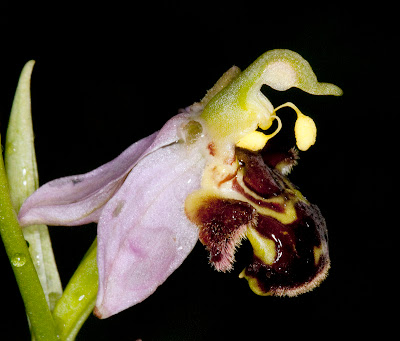 |
| Bee orchid, Ophrys apifera, on Orchis Bank, showing pollinia. 25 June 2011. |
We went into the area labelled as Orchis Bank, Darwin's name for one of the areas he studied. Naturally, there was a focus on orchids, and even though the weather this year has not encouraged them, there were plenty of common spotted orchids and common twayblades, with pyramidals scattered among them. Several bee orchids were spotted, and later on, some fragrant orchids. But these showy specimens were only the tip of a wealth of plant life.
I was interested to see a lush black bryony, climbing an ash sapling, which had a shoot with dark purple leaves. I wonder if that is a somatic variation or a true reproducible variety. Other shoots of the same plant looked quite normal.
As usual, the group spread out and straggled. I was often at the back, taking photographs. I saw a few Helix pomatia, the large edible snails that were introduced by the Romans. They were sheltering in small hollows which seemed to be just their size. They did not seem to want to emerge from their shells.
 |
| Weevil, Apoderus coryli, on my hand, on Orchis Bank. 25 June 2011. |
The open area was full of yellow flowers, one of the many local species that resemble dandelions. It is interesting that all the local meadows seem to have one of these species predominent. Often it's cat's-ear, but in this case it was the rough hawkbit, Leontodon hispidus. There were also many specimens of hairy St. John's wort, which added to the general yellowness. Marmalade hoverflies were everywhere, often sitting on the yellow flowers and letting me get close up with the camera.
The line of people wound along the narrow path, singly and in groups, turned round at the end and moved back lower down the hill. A few returned the way they came, and others went on and back a different way. I went along to the track on the lower path and climbed the gate into Musk Orchid Bank, which I had visited once before on Ewa Prokop's primrose walk.
Back in March, the grass was short and primroses stood up above it. Now all the plants stood tall. I saw several marbled white butterflies flitting about, but I didn't want to chase them until they settled because it would have meant trampling down all the plant life. The one I came across that was already settled had lost a piece from both hind wings; perhaps it had a close encounter with a bird and was lucky to get away.
I was following the hint of a track that might have been made by a fox, or by one person going unseen ahead of me. There were a few large skippers and I also saw one large field scabious, its light blue flowers standing above all the rest.
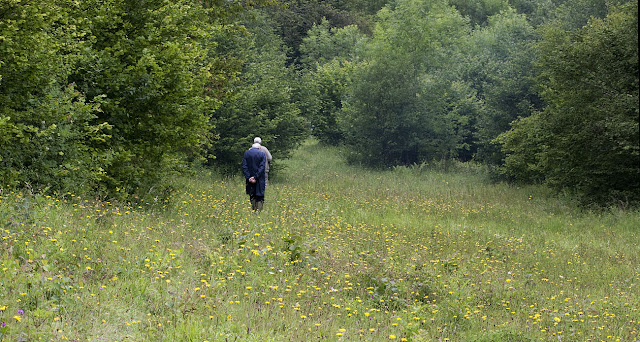 |
| Wandering along Orchis Bank. The yellow flowers are mostly rough hawkbit, Leontodon hispidus. 25 June 2011. |
 |
| Ringlet butterfly, Aphantopus hyperantus, basking on Orchis Bank. 25 June 2011. |
 |
| Marmalade hoverfly, Episyrphus balteatus, on hairy St. John's wort, Hypericum hirsutum, on Orchis Bank. 25 June 2011. |
 |
| Fragrant orchid, Gymnadenia conopsia, on Orchis Bank. 25 June 2011. |
 |
| Marbled white butterfly, Melanargia galathea, missing some pieces of wing, on Musk Orchid Bank. 25 June 2011. |
 |
| Florets of field scabious, Knautia arvensis, on Musk Orchid Bank. 25 June 2011. |
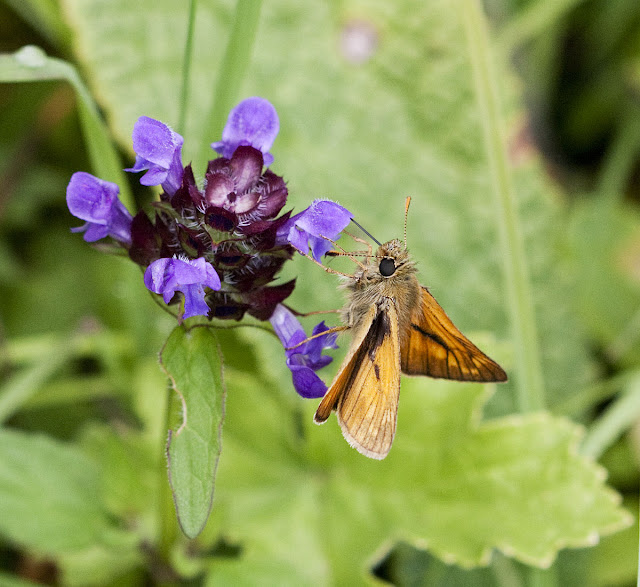 |
| Large skipper, Ochlodes venatus, male, feeding on selfheal, Prunella vulgaris, on Musk Orchid Bank. 25 June 2011. |
All the photos in this post were taken with a Canon EOS 450D and an EF 100mm macro lens. For the closeups I used a ring flash.
If this was interesting, you might like to see Irene Palmer's web presentation on Downe Bank: Darwin's 'Entangled Bank' at Downe, A Warden's Tale.
Labels:
animals,
butterflies,
Darwin,
Downe,
environment,
flowers,
insects,
invertebrates,
mini-beasts,
Orpington Field Club,
plants
Saturday, 25 June 2011
Malachius bipustulatus
 |
| Red-tipped flower beetle, Malachius bipustulatus, on an ox-eye daisy, Leucanthemum vulgare. 4 May 2011. |
In this adult form it eats pollen. Here it is on an ox-eye daisy. Below, there are three beetles on another ox-eye daisy, and you can see that a fourth is making its way up the stem to join them. The bottom photo is a close-up on a goat's-beard, Tragopogon pratensis.
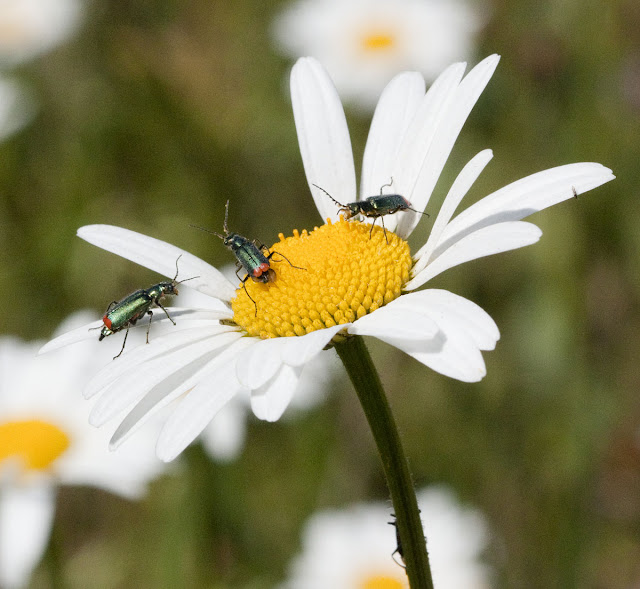 |
| Red-tipped flower beetle, Malachius bipustulatus, on ox-eye daisy, Leucanthemum vulgare. Hayes Common, 21 May 2011. |
 |
| Malachius bipustulatus on flower of goat's-beard, Tragopogon pratensis, on Hayes Common, 27 May 2011. |
Labels:
flowers,
Hayes Common,
High Elms,
insects,
invertebrates,
mini-beasts
Friday, 24 June 2011
Thursday, 23 June 2011
Ups and Downs
 |
| An inquisitive Dexter cow near Biggin Hill. 21 June 2011. |
Previous walks planned by Ewa had covered parts of this route, but the whole feel of the countryside was different at this time of year. More and different wildflowers were prominent in the meadows and fields. Also, I have learned a lot over the past few months, some of if from Ewa, and the more you know, the more you see.
This was Ewa's last walk for Bromley Countryside Services. A third of Bromley's rangers are losing their jobs in the current series of cutbacks. All the jobs are being redefined, and it is likely that there will be fewer of these walks and less support for the "friends" groups which care for their local country parks, commons and woods. Of the six rangers I have met, three will be retiring or will become redundant, and I wish them well. They are people with vast knowledge of their areas and a real feel for conservation, and their loss cannot be good for Bromley's countryside.
So, I arrived early at Pratt's Bottom village green; very neat, very middle-class. Yes, I think the name is funny too. I got a couple of close-up photos before the others arrived — just two walkers and Ewa — and we set off uphill along a bridleway.
 |
| Flowers of male white bryony, Bryonia dioica. 21 June 2011. |
Ewa was telling us about the countryside we passed through, and pointing out interesting plants and places where she had worked with volunteers to lay new hedgerows. We saw grasses like the drooping wood melick that lined the shady path; coppiced hazels; flowering black horehound (which Ewa knew as stinking horehound) and hedge woundwort, musk mallow and hedge bedstraw. There were butterflies; meadow brown, ringlet, large skipper.
We passed by Charmwood Farm and the gated end of a long, lime-lined track and came to an unnamed valley. At first sight this seemed to be just grassland, but there were many other plants hidden among the stalks. We saw the yellow flowers of black medick and St. John's wort, and as we climbed the far side some wild basil, a patch of wild thyme, and yes, some pyramidal orchids.
This was the same valley I photographed on 25th January for my first entry in this blog. That was one of Ewa's walks too, though she had not been able to come out that day and Jenny Price led it.
Then, some more woods and fields. The wind blew, cooling us down nicely. A day-flying moth, a white ermine, landed on one of us and promptly died, a very strange occurrence. Then we walked through the churchyard at Cudham and down into Cudham valley, another beautiful place. We came through this valley on Ewa's primrose walk in March. The solitary tree in the background of the photo of meadow cranesbill, fourth from the bottom below, is the same one that appears in the second photo down in that earlier post, and there are also photos showing Bottom Barn Farm in both posts.
 |
| Pyramidal orchid, Anacamptis pyramidalis, in a Bromley Valley. 21 June 2011. |
In this valley the purple flowers of common knapweed and the white-and-yellow of ox-eye daisies were prominent in the long grass. Marbled white butterflies flew across the path.
This time we walked straight across the valley and up the hill through the ancient woods of Twenty Acre Shaw. That was quite a steep climb, and my ears popped at the top. On the far side, the last valley on our walk was less salubrious. It was small where we crossed it, more of a dip than a valley, and at the bottom our path led through a yard surrounded by ramshackle buildings with corrugated iron roofs and a skip full of rubbish.
Now we were approaching Biggin Hill. There was one slight mishap when we started to walk through someone's garden; the stile was thirty yards away, hidden in a hedge. We passed a field containing a miniature cow, a Dexter. Soon we were at the edge of suburbia and the end of the walk. Luckily for us, Ewa gave us a lift back to our cars at the starting point.
As we neared the village green it started to rain. Good timing. Then we shook hands and said goodbye to Ewa for the last time.
 |
| Pratt's Bottom Village Green. 21 June 2011. |
 |
| Ewa pointing out hedge bedstraw, Galium mollugo, on a farm near Pratt's Bottom. 21 June 2011. |
 |
| An old beech tree, Fagus sylvatica, in the woods east of Cudham. 21 June 2011. |
 |
| Ancient yew tree, Taxus baccata, in Cudham churchyard. 21 June 2011. |
 |
| Meadow cranesbill, Geranium pratense, in Cudham Valley. 21 June 2011. |
 |
| Cudham valley and Bottom Barn Farm with common knapweed and ox-eye daisy. 21 June 2011. |
 |
| Climbing the steps in Twenty Acre Shaw on the side of Cudham Valley. 21 June 2011. |
 |
| The group having just emerged from someone's garden, east of Biggin Hill. The actual stile is just behind me. 21 June 2011. |
Wednesday, 22 June 2011
Mandarins
 |
| Female mandarin duck, Aix galericulata, with ducklings, on Keston upper pond. 15 June 2011. |
Tuesday, 21 June 2011
Broad-Leaved Dock
 |
| Seed spike of broad-leaved dock, Rumex obtusifolius. Hayes Street Farm, 13 June 2011. Taken with my EOS 450D and 100mm macro lens. |
Monday, 20 June 2011
Jubilee Bumblebees
 |
| Red-tailed bumblebee, Bombus lapidarius, feeding on white clover, Trifolium repens. Jubilee Country Park, 19 June 2011. |
This walk was designed to show us some of the park's bumblebees, and teach us about them at the same time. Jenny Price of BCS led. She used the common names of bumblebees, which I found confusing, as I did not know any of them, only the Linnaean names. But it sounded more friendly for the inexperienced members of the group. There were about 20 in the group, including three young children who were particularly enthusiastic and able to identify many invertebrates.
It can be hard to identify bumblebees. Some species look alike; the males, females and queens of one species can look quite different from each other; and to add interest, some other insects look a lot like them. But there are not many that you are likely to see. Of the 22 species of British bumblebees, only six are common, and we didn't see all of those on this day.
 |
| Caterpillar of six-spot burnet moth, Zygaena filipendulae, on bird's-foot trefoil, Lotus corniculatus. Jubilee Country Park, 19 June 2011. |
There were plenty of other insects to give us pleasure. Quite soon one of the group spotted some caterpillars and pupa cases of the six-spot burnet moth. Both six-spot and five-spot burnets were flying around, there were plenty of meadow brown butterflies, and later on a ringlet rested for a while on a walker's hat. I photographed a pair of small skippers that had been circling each other tightly in flight, sometimes resting for few seconds.
There were several flower beetles, including the bright iridescent green Oedemera nobilis and its smaller, browner relative Oedemera lurida. Once, as I was sitting in a meadow, a soldier beetle flew up and landed next to me, posing helpfully. It was Cantharis nigra (not pellucida as I had thought at first). There were also a few seven-spot ladybirds around.
I saw three species of hoverfly. A marmalade hoverfly, Episyrphus balteatus; one I haven't identified; and a Merodon equestris, one of the bumblebee imitators. Another of the imitators is in an earlier post here: Bumblebee and Hoverfly.
So what about the bumblebees? Quite a few were found when the sun came out. Most were the red-tailed, Bombus lapidarius, which seemed to prefer the white clover which was widespread in the areas with short grass and stunted dropwort. We looked for a species that likes woodland, Bombus hypnorum, but found only one possible specimen, which Jenny thought might be a cuckoo bumblebee. But it was an old individual, partly bald, so I am not sure.
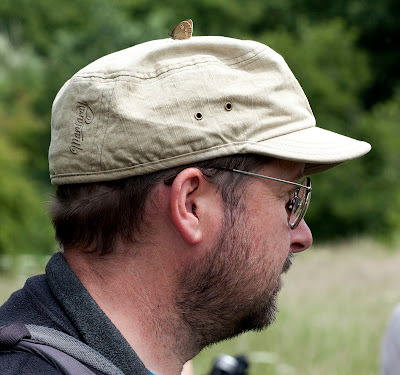 |
| Ringlet butterfly, Aphantopus hyperantus, on a walker's hat. Jubilee Country Park, 19 June 2011. |
Cuckoo bumblebees take over the nests of normal bees, evict the queen and fool the workers into rearing their own young; they look very much like the species they parasitise, so identification in the field is tricky.
To examine the live bees, they were put into a tube in which a soft plunger pushed the bees up against a mesh. It looked awkward, but didn't harm the bees, which flew off afterwards. I am including a photo of a white-tailed bumblebee, Bombus lucorum, in this temporary restraint.
The photo of the group in the meadow was taken with my Ixus 100; all the others were taken with my Canon EOS 450D with the 100mm macro lens.
 |
| Jenny Price leading the group into a meadow. Jubilee Country Park, 19 June 2011. |
 |
| White-tailed bumblebee, Bombus lucorum, temporarily immobilised for examination. Jubilee Country Park, 19 June 2011. |
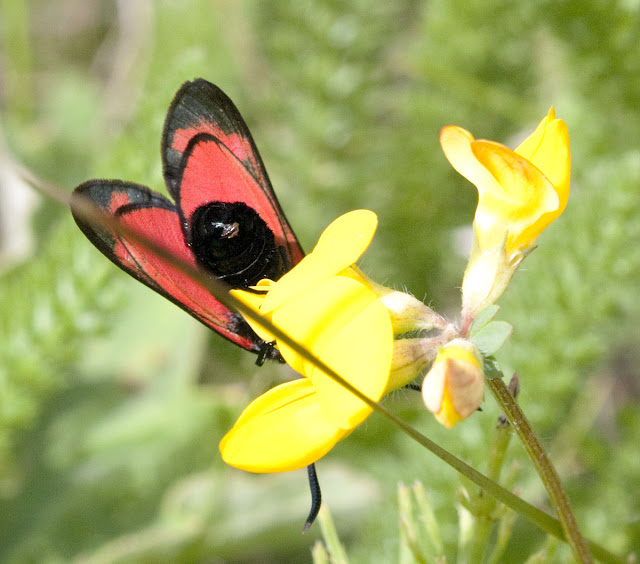 |
| The vivid underside of a six-spot burnet moth, Zygaena filipendulae. Jubilee Country Park, 19 June 2011. |
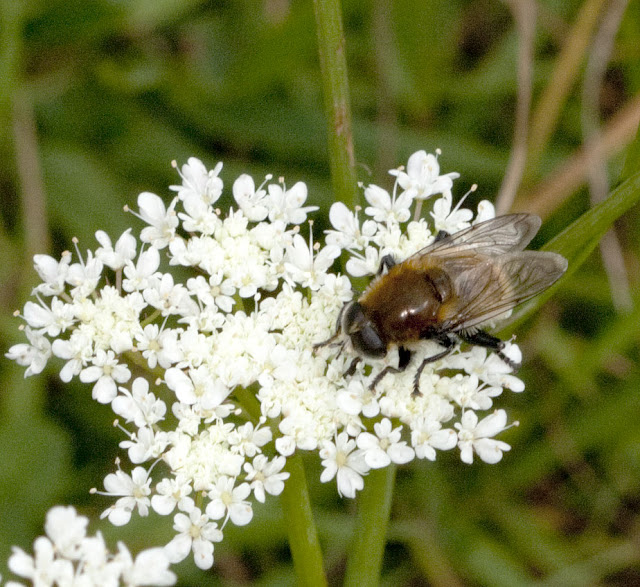 |
| Hoverfly, Merodon equestris, a bumblebee imitator, on corky-fruited water dropwort, Oenanthe pimpinelloides. Jubilee Country Park, 19 June 2011. |
 |
| A soldier beetle, Cantharis nigra. Jubilee Country Park, 19 June 2011. |
 |
| An Essex Skipper, Thymelicus lineola, above, and a Small Skipper, Thymelicus sylvestris, below. Jubilee Country Park, 19 June 2011. |
Labels:
butterflies,
insects,
invertebrates,
Jubilee Country Park,
mini-beasts,
moths,
walks
Sunday, 19 June 2011
Varied Carpet Beetle
 |
| Varied carpet beetle, Anthrenus verbasci, on a Euphorbia flower in my back garden. 1 June 2011. It's about 3mm long. Taken with my EOS 450D and 100mm macro lens. |
Saturday, 18 June 2011
Friday, 17 June 2011
Keston Grasslands
 |
| Greater yellow rattle, Rhinanthus angustifolius. Ravensbourne meadow, 15 June 2011. |
This time we started at a different spot, by Keston Ponds, and looked at some of the acid grassland nearby before moving across the heath, past Keston Bog, and on to the dry and wet Ravensbourne meadows. Naturally I don't want to repeat what I have already covered, so here are some highlights from this trip.
On the dry grassland where Juncus squarrosus grows, on a poor soil made up of Blackheath gravel, I saw a little butterfly, like a meadow brown but smaller, identified by Judy as a small heath. It was very mobile (kept flying off when I got close) and I only got a partial photo of it, but enough to confirm the identification. It was good to see this; the species is in decline.
We had a closer look at the area around the bog than I took last time. Part of it is still full of white fluffy cottongrass. The small yellow flowers of tormentil were scattered around, and Judy says we should soon see bog asphodel. There were several rushes and sedges; Judy pointed out one new to the bog, Carex demissa, common yellow sedge.
 |
| The front of a slowworm, Anguis fragilis, and some cast skin. Ravensbourne meadow, 15 June 2011 |
The bog had suffered after Darwin's time from a misplaced attempt to protect it from trampling and depradation by allowing trees to grow up around it, to conceal it. But bog plants such as sundew need light, which was shaded out; a low nutrient environment, ruined by leaf litter; and plenty of water, which was being sucked up by the trees; so the bog fell into a poor state.
Recently, the nearest trees have been removed, and the leaf litter on the sides of the small depression has been scraped off. The old flora are coming back. There are still no sundews, but now that the wet ground surface is exposed again there are other good things, like the sedge mentioned above. But given our generally drier climate, it might never return to being a true valley bog as Darwin saw it.
In the meadows we looked under two of the small corrugated iron shelters and saw several slowworms — many more than we saw on the reptile walk in May. One of the shelters also had a busy ant's nest. The other contained some cast skin, shown in this photo. It's a cropped corner of a rather dark image, and not very clear; I didn't spot this slowworm until I looked at the photo on my computer.
Walking through the woods between the meadows, Judy pointed out specimens of broad buckler fern and male fern by the path. In the wet meadows were the purple flowers of marsh thistles. To one side, a statuesque Italian black poplar tree, not in the best of health.
 |
| An Italian black poplar to one side of a meadow. 15 June 2011. |
One of the dry meadows had some patches of greater yellow rattle, probably brought in on the machinery used to cut the grass, as we know happened with the corky-fruited water dropwort that came from Jubilee Country Park. On one of the wet meadows, someone had recently camped overnight and had a camp fire, potentially eradicating the black sedge that Judy had been so pleased to find two weeks ago. It takes a lot of work to keep this common in shape and gradually improve it, and it's not always a forward progression.
Back at the ponds, Judy said goodbye and a few of us went off towards the upper car park. At this point I was thinking: Well, I've got some quite interesting photos, but nothing really special. Then a damselfly landed on Sally's arm. I think it was an emerald damselfly, but it's not quite like any of the illustrations in my books, and I will amend this if I am proved wrong. A little further on, we saw where some of the yellow water lilies had been pulled up by someone. One of the flowers was near the bank, floating free in the water. At last, a chance to test whether they really do smell of alcohol! And indeed they do, quite strongly, justifying their alternative common name of brandybottle. The flower was big and fleshy, and the stem was bulky and weak.
Loosely attached to the side of this flower was the exuvium of a damselfly or dragonfly, the empty skin which it had moulted when emerging as an adult. You really can't go far on this common without seeing interesting things, if you watch out for them. Also interesting was a group of people fishing illegally — these ponds are part of the river Ravensbourne, and it was still the close season for coarse river fishing until the end of the day (15th June). Other groups of fishermen by the middle pond were merely reconnoitring and waiting out the day.
 |
| Judy John pointing out a sedge new to Keston Bog, Carex demissa, the common yellow sedge. Keston Bog, 15 June 2011. |
 |
| Damselfly, possibly an emerald, Lestes sponsa. Keston middle pond, 15 June 2011. |
 |
| Flower of yellow water lily, Nuphar lutea, aka brandybottle, with damselfly or dragonfly exuvium. Keston upper pond, 15 June 2011. |
 |
| Flower of yellow water lily, Nuphar lutea, aka brandybottle, with damselfly or dragonfly exuvium. Keston upper pond, 15 June 2011. |
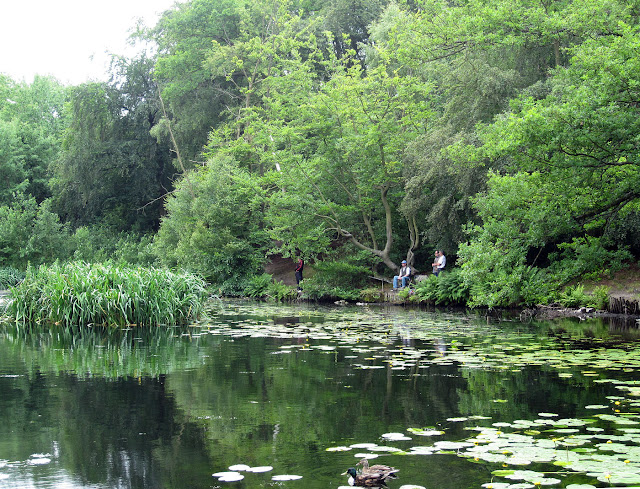 |
| Fishing out of season. The statutory coarse fish close season applies between 15 March and 15 June inclusive. This is Keston upper pond, part of the Ravensbourne river, on 15 June 2011. |
All the photos in this post were taken with my little Ixus 100 camera.
Labels:
animals,
environment,
insects,
invertebrates,
Keston Common,
mini-beasts,
plants,
trees
Subscribe to:
Comments (Atom)

